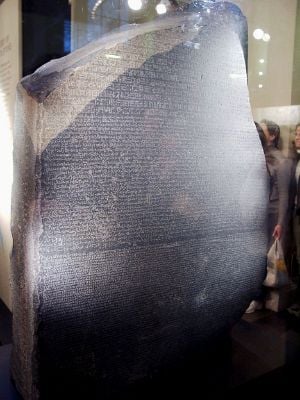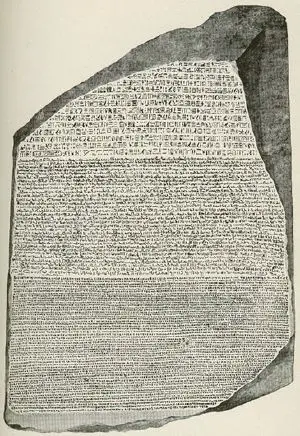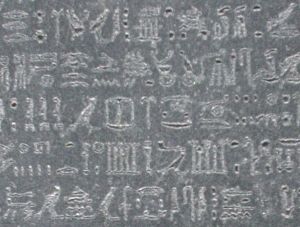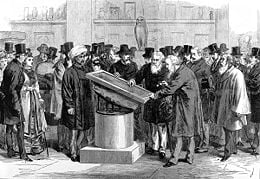Rosetta Stone
The Rosetta Stone is an ancient stele inscribed with the same passage of writing in two Egyptian language scripts and in classical Greek. It was created in 196 B.C.E., discovered by the French in 1799, and translated in 1822 by the Frenchman Jean-Fran├žois Champollion. Comparative translation of the stone assisted in understanding many previously undecipherable examples of Egyptian hieroglyphic writing, changing the course of Egyptology. The phrase "Rosetta Stone" is often used to indicate something that is a key to deciphering hidden meaning, as this stone was the key to finally unlocking the mysteries of the great civilization of ancient Egypt.
History
The Rosetta Stone is 45 inches high at its tallest point, 28.5 inches wide, and 11 inches thick. Weighing approximately 1,676 pounds, it was originally thought to be granite or basalt but is now described as granodiorite. The stone has a dark grey-pinkish tone with a pink streak running through it.
Creation of the stone
The stone is inscribed with a decree setting up the cult of the pharaoh for Ptolemy V who was the fifth ruler of the Hellenistic Ptolemaic Dynasty. The Greeks had ruled Egypt from 305 B.C.E., after the conquest of Persia by Alexander the Great, until 30 B.C.E. Before the Greeks, Egypt had been conquered by Persia and when Ptolemy I was appointed the ruler of Egypt, he was welcomed into Egypt as part of the family of Alexander. Greek language and culture flourished for hundreds of years in Egypt alongside the native Egyptian language and culture. Thus, the text on the Rosetta Stone was written in both Greek and Egyptian scripts.
Ptolemy V began his rule when he was five years old, and thus much of the ruling of Egypt during his reign was done by Regents and royal priests. With the Rosetta Stone, these priests continued the precedent set by Ptolemy III (whose decree appears on the Stone of Canopus) of issuing decrees to the populace, instead of the pharaoh himself, in order to maintain support for the dynasty. They had the decrees inscribed on stone and erected throughout Egypt. The Rosetta Stone is a copy of the decree issued in the city of Memphis, issued upon the coronation of Ptolemy V when he was 13 years old.
The language is lost
After the downfall of Cleopatra, Egypt fell under Roman rule. Within one hundred years, the Romans lost all knowledge of Egyptian hieroglyphics. Most Romans did not value them or even consider them a language at all.
When the Roman Empire fell, the Middle Ages began and Egypt experienced an era of relative chaos. Some knowledge of hieroglyphics continued, however, because of the idea that the bitumen used in the preparation of Egyptian mummies had healing properties. The trade in mummies allowed examples of hieroglyphs to reach Europe. The study of hieroglyphs continued with fruitless attempts at decipherment by European scholars, notably Johannes Goropius Becanus in the sixteenth century, Athanasius Kircher in the seventeenth, and Georg Zo├źga in the eighteenth century.[1] However, any progress in translation was very slow.
Modern re-discovery
When Napoleon reached Egypt in 1798, the French founded an Institut d'Egypte in Cairo, bringing many scientists and archaeologists to the region. Napoleon originally expected to take Egypt quickly, but due to the skill of the British Admiral Nelson, they were forced to stay for three years. This allowed the 167 scientists, technicians, mathematicians, and artists the army had brought with them much time for study of Egyptian culture and artifacts.
French Army engineer, Pierre-Fran├žois Bouchard, discovered the stone on July 15, 1799, while he was guiding construction works in Fort Julien near the Egyptian port city of Rosetta (present-day Rashid). He recognized its importance and showed it to General Jacques-Fran├žois Menou. They decided to send the artifact to the Institut d'├ëgypte in Cairo, where it arrived in August 1799. The French language newspaper Courrier de l'Egypte announced the find in September 1799.
After Napoleon returned to France in late 1799, the scholars remained behind along with a defensive force of French troops. French commanders held off British and Ottoman attacks until March 1801, when the British landed on the Aboukir Bay. Scholars carried the Rosetta Stone from Cairo to Alexandria alongside the troops. However, the French troops in Cairo surrendered on June 22 and in Alexandria on August 30.
After the French surrender, a dispute arose over the fate of French archaeological and scientific discoveries in Egypt. Finally, Colonel Tomkyns Hilgrove Turner escorted the stone to Britain aboard a captured French frigate L'Egyptienne in February 1802. On March 11, 1802 it was presented to the Society of Antiquities. Later it was taken to the British Museum, where it has been ever since. White painted inscriptions on the artifact state "Captured in Egypt by the British Army in 1801" on the left side and "Presented by King George III" on the right.
Unlocking the code
The Rosetta Stone was inscribed with three scripts so that it could be read not only by the local populace, but also by visiting priests and government officials. The first script was Egyptian hieroglyphs, the script used for religious documents and other important communications. The second was Demotic Egyptian, which was the common script of Egypt. The third was Greek, which was the language of the court.
The stone displays the same Ptolemaic decree of 196 B.C.E. in all three scripts. The Greek script of the Rosetta Stone begins: Basileuontos tou neou kai paralabontos t─ôn basileian para tou patrosÔÇŽ (Greek: ╬ĺ╬▒¤â╬╣╬╗╬Á¤Ź╬┐╬Ż¤ä╬┐¤é ¤ä╬┐¤ů ╬Ż╬ş╬┐¤ů ╬║╬▒╬╣ ¤Ç╬▒¤ü╬▒╬╗╬▒╬▓¤î╬Ż¤ä╬┐¤é ¤ä╬Ě╬Ż ╬▓╬▒¤â╬╣╬╗╬Á╬»╬▒╬Ż ¤Ç╬▒¤ü╬Č ¤ä╬┐¤ů ¤Ç╬▒¤ä¤ü¤î¤éÔÇŽ), or ÔÇťThe new king, having received the kingship from his fatherÔÇŽ.ÔÇŁ It is a decree from Ptolemy V, describing various taxes he repealed (one measured in ardebs (Greek artabai) per aroura), and instructing that statues be erected in temples and that the decree be published in the writing of the words of gods (hieroglyphs), the writing of the people (demotic), and the Wynen (Greek; the word is cognate with Ionian) language.
The three-stone series
The Hellenistic Ptolemaic dynasty, which ruled Egypt from 305 B.C.E. to 30 B.C.E., issued a series of decrees over the course of their reign. The Rosetta Stone was included in the third part of a series of three decrees, the first from Ptolemy III (the Decree of Canopus), the second from Ptolemy IV (the Decree of Memphis (Ptolemy IV)), and the third from Ptolemy V.
Multiple copies of the Ptolemaic Decrees were erected in temple courtyards, as specified in the text of the decrees. There are approximately two copies of the Stone of Canopus, two of the Memphis Stele (one imperfect) and two and a half copies of the text of the Rosetta Stone, including the Nubayrah Stele and a pyramid wall inscription with "edits," or scene replacements, completed by subsequent scribes.
The Stele of Nubayrah, found early 1880s, and the text engraved in the Temple of Philae contain the same message as the Rosetta Stone, and was used to complete missing Rosetta Stone lines.
Translation
In 1814, British physicist and Egyptologist Thomas Young finished translating the enchorial (demotic) text, which was phonetic but contained some of the ancient hieroglyphic text. During the years of 1822ÔÇô1824, Jean-Fran├žois Champollion began publishing papers on the decipherment and became known as the translator of the Rosetta Stone. Champollion could read both Greek and Coptic language and greatly expanded on Young's work. He was able to figure out what the seven Demotic signs in Coptic were. Upon the advice of Young, he looked for examples of the Cartouche, a group of hieroglyphics that were circled and were usually the names of royalty. By comparing these, they could begin deciphering the text.
Champollion correctly understood that the hieroglyphs were not only ideographs but also had a phonetic representation. The names of those foreign to Egypt had to be spelled out phonetically, much like modern Japanese. Comparing these signs as they were used in the Coptic version, he was able to work out what they stood for. Then he began tracing these Demotic signs back to hieroglyphic signs. By working out what some hieroglyphs stood for, he could make educated guesses about what the other hieroglyphs stood for.
In 1858 the Philomathean Society of the University of Pennsylvania published the first complete English translation of the Rosetta Stone. Three undergraduate members, Charles R. Hale, S. Huntington Jones, and Henry Morton, made the translation. The translation quickly sold out two editions and was internationally hailed as a monumental work of scholarship. In 1988, the British Museum bestowed the honor of including the Philomathean Rosetta Stone Report in its select bibliography of the most important works ever published on the Rosetta Stone. The Philomathean Society continues to display a full-scale cast of the stone in its meeting room at the University of Pennsylvania.
Today
The Rosetta Stone has been exhibited in the British Museum since 1802, with only one break, from 1917ÔÇô1919. Toward the end of the First World War, in 1917, when the Museum was concerned about heavy bombing in London, they moved it to safety along with other portable, important objects. The Rosetta Stone spent the next two years in a station on the Postal Tube Railway 50 feet underground at Holborn.
In July 2003 the Egyptians demanded the return of the Rosetta Stone. Dr. Zahi Hawass, secretary general of the Supreme Council of Antiquities in Cairo, told the press: "If the British want to be remembered, if they want to restore their reputation, they should volunteer to return the Rosetta Stone because it is the icon of our Egyptian identity." In 2005, having received a life-size replica of the Rosetta Stone from the British Museum which was put on display in the newly opened Rashid National Museum, Hawass was negotiating for a three month loan, with the eventual goal of its permanent return to Egypt. In December 2009, he proposed to drop his claim for the permanent return of the Rosetta Stone if the British Museum loaned the stone to Egypt for three months, for the opening of the Grand Egyptian Museum at Giza in 2013.[2]
Notes
- ÔćĹ John Ray, The Rosetta Stone and the rebirth of Ancient Egypt (Harvard University Press, 2007. ISBN 978-0674024939).
- ÔćĹ "Rosetta Stone row 'would be solved by loan to Egypt'", BBC News, (December 8, 2009). Retrieved June 13, 2011.
ReferencesISBN links support NWE through referral fees
- Budge, E.A. Wallis. The Rosetta Stone. Mineola, NY: Dover Publications, 1995. ISBN 0486261638
- Downs, Jonathan. "Romancing the Stone." History Today 56(5) (2006): 48ÔÇô54.
- Downs, Jonathan. Discovery at Rosetta: The Stone that Unlocked the Mysteries of Ancient Egypt. Skyhorse Publishing, 2008. ISBN 978-1602392717
- Parkinson, Richard. Cracking Codes: the Rosetta Stone, and Decipherment. Berkeley, CA: University of California, 1999. ISBN 0520222482
- Ray, John. The Rosetta Stone and the Rebirth of Ancient Egypt. Cambridge, MA: Harvard University Press, 2007. ISBN 978-0674024939
- Sol├ę, Robert, and Valbelle, Dominique. The Rosetta Stone: The Story of the Decoding of Hieroglyphics. New York, NY: Four Walls Eight Windows, 2002. ISBN 1568582269
External links
All links retrieved December 16, 2022.
- The Egyptian Government. The Story of ÔÇťDescription of Egypt.ÔÇŁ
- High Resolution Image of the Face.
- Translation of the Rosetta Stone from The Nile, Notes for Travellers in Egypt, by E. A. Wallis Budge, 9th Edition, London, Thos. Cook and Son, [1905], pp. 199-211.
Credits
New World Encyclopedia writers and editors rewrote and completed the Wikipedia article in accordance with New World Encyclopedia standards. This article abides by terms of the Creative Commons CC-by-sa 3.0 License (CC-by-sa), which may be used and disseminated with proper attribution. Credit is due under the terms of this license that can reference both the New World Encyclopedia contributors and the selfless volunteer contributors of the Wikimedia Foundation. To cite this article click here for a list of acceptable citing formats.The history of earlier contributions by wikipedians is accessible to researchers here:
The history of this article since it was imported to New World Encyclopedia:
Note: Some restrictions may apply to use of individual images which are separately licensed.



